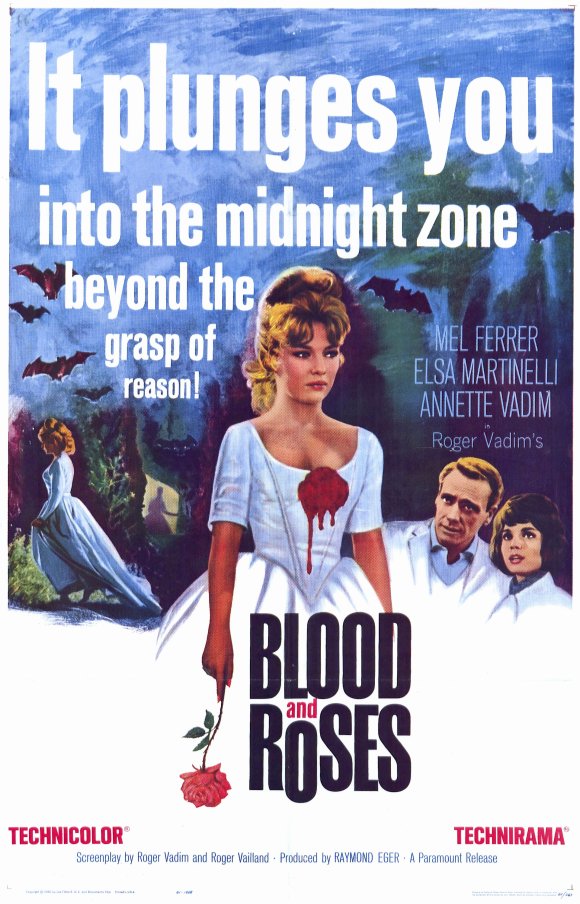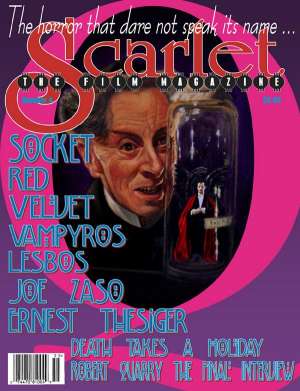“To Die of Pleasure”: Roger Vadim’s Blood and Roses
 Roger Vadim was a pioneer in sexually explicit filmmaking. His 1956 film And God Created Woman (starring Brigitte Bardot, to whom he was then married) pushed the boundaries of acceptable on-screen sexuality in mainstream cinema. At the same time, his style, tastes, and sensibilities transcended what had been previously classified as pornography. By combining an erotic sensibility with a talent for visual storytelling, Vadim paved the way for more sexually explicit imagery in mainstream cinema not only in France and in the rest of Europe, but also, eventually, in the United States.
Roger Vadim was a pioneer in sexually explicit filmmaking. His 1956 film And God Created Woman (starring Brigitte Bardot, to whom he was then married) pushed the boundaries of acceptable on-screen sexuality in mainstream cinema. At the same time, his style, tastes, and sensibilities transcended what had been previously classified as pornography. By combining an erotic sensibility with a talent for visual storytelling, Vadim paved the way for more sexually explicit imagery in mainstream cinema not only in France and in the rest of Europe, but also, eventually, in the United States.
Et Mourir de Plaisir, the French title of Roger Vadim’s erotic vampire film Blood and Roses (1960), translates as “And to Die of Pleasure,” a title that hints at the pleasures—and the deaths—that we are about to witness.
Blood and Roses is Vadim’s retelling of Sheridan Le Fanu’s (credited as Le Vanu in Vadim’s opening credits) lesbian vampire tale “Carmilla.” Set in Italy rather than Le Fanu’s Styria, Vadim’s Carmilla is not the barely remembered figure of a remote past, but a modern woman with a modern tale to tell. In an opening sequence, we are introduced to Carmilla through a voiceover in which she begins the story of her most recent incarnation.
The story is told as a flasback. A marriage is about to take place, and the festivities are being arranged. Leopoldo is about to marry Georgia, much to his cousin’s (Carmilla) chagrin. Leopoldo is of the family Von Karnstein, and Carmilla is his “first cousin and childhood playmate, last descendant of the Austrian branch” of the family von Karnstein.
When a family servant reveals that it will be difficult to find villagers to help set up the fireworks display—which, as it turns out, is to be based in the old abbey, the site of the family cemetery—Leopoldo and Carmilla reveal that the von Karnsteins were known vampires. Vampires, that is, until 1765, when the peasants revolted and staked the members of the Karnstein family whose bodies resided in the abbey. All of the members were put to rest, and the bodies exhumed, except for Carmilla’s distant relative, Mircalla, to whom Carmilla bears more than a passing resemblance. Her body was moved, and her eternal life saved, by her fiancé, Ludwig, to whom, it just so happens, Leopoldo also bears a more than passing resemblance.
Ludwig, it seems, was unfaithful to Millarca’s memory. On the eve of three subsequent marriages, Ludwig’s fiancee died. “Millarca’s doing, I suppose,” Georgia says.
Pointing to the rose resting in the hand of the long-dead Millarca in the family’s heirloom, a protrait, Georgia asks Carmilla, “The rose is faded. Why?”
“Flowers always fade when a vampire touches them,” Carmilla responds. And, of course, the roses in the film wilt and fade at Carmilla’s slightest touch.
And thus, we are introduced to the love triangle that will form the rest of the story: Carmilla, Georgia, and Leopoldo.
Vadim takes quite a few liberties with the original story as penned by Le Fanu. By introducing Leopoldo (and Ludwig before him), Vadim transforms Le Fanu’s tale from one of love and affection between two young women to one of a jealous woman’s efforts to keep her man, even if that means seducing the woman he loves.
While rather tame by today’s standards, Blood and Roses raised more than a few eyebrows in its day. Georgia is clearly quite taken with Carmilla’s brooding sensuality. And Carmilla, although she embarks on her flirtation with Georgia with Leopoldo in mind, seems more than a little intrigued by the beautiful innocence and heartfelt naiveté of the friendly and gregarious Georgia.
Alone with Georgia in the greenhouse where they’ve taken shelter from the rain, Georgia tells Carmilla that she knows that Carmilla is in love with Leopoldo. In that moment, Carmilla notices a drop of blood on Georgia’s lower lip. She moves slowly toward Georgia, while Georgia stands transfixed, and kisses Georgia lightly, gently sucking the drop of blood from her mouth.

Carmilla’s attraction to Georgia is explained away by Giuseppe, the groundskeeper and one of the more superstitious among the castle’s inhabitants. “Do they only kill women?” the girls ask Giuseppe.
“If it’s a female vampire,” he responds. He goes on to warn, “The worst thing is when a vampire identifies her life with her victim. Then, when she kills her, she becomes a vampire, too.”
The continuing appeal of Blood and Roses is in its evocative style and tone. Gothic romanticism permeates the film, with its remote location and crumbling façade (the movie was filmed at Hadrian’s Villa in Tivoli, Italy). The music (an original score composed by Jean Prodromidès) is beautiful and the melodies, haunting, especially the Irish harp as played by Elene Polonska.
The gothic sensibility of Blood and Roses is brought into the (1960s) present with the occasional touch of realism: Carmilla’s love of the current Latin dance tunes; the legacy of World War II, and air travel. And the dream-like quality of the film is added a certain luster with the surrealistic dream sequences that pepper the film.
The film shares an air with other films of the era; Mario Bava’s Black Sunday comes immediately to mind. Like Vadim’s Carmilla, Bava’s Katia is a young woman possessed by Princess Asa (both played by Barbara Steele), the long-dead spirit of a deceased, supernatural ancestor. It’s hard to say whether one film influenced the other, as they were both made in 1960. But Bava and Vadim certainly shared influences, and both were to influence the filmmakers—and the entire film industry—that followed in their wake.
And what is the fate of our beloved Carmilla? Is she, as she believes, possessed by the long dead spirit of her ancestor, the vampire Millarca? Or is she, as the “modernists” claim, a victim of her own fantasy, brought about by her desire for her cousin, Leopoldo?
Perhaps we will never know for certain.
February was a busy month, and Women in Horror month completely passed me by. But when I saw that the Final Girl Film Club pick of the month was the lesbian vampire classic Blood and Roses, it was like getting a second chance. Blood and Roses is a favorite of mine, and it’s a delight to be a part of Final Girl’s Film Club!
Chinese Hopping Vampires
I’ve just discovered Squidoo, and have started posting lenses. A lens is like an article, a focus on a single topic, but with lots of nifty modules to help add interactivity. It’s been a great exercise in writing for the web.
One of my first lenses is based on “What I Know About Chinese Vampires,” a background piece I wrote several years ago for Rob Fitz for his film, God of Vampires. It’s shorter than the piece I wrote way back then, and includes information about and links to Chinese vampire movies.
If you’re interested in reading more, check out “Chinese Hopping Vampires” on Squidoo.
Vampyros Lesbos: Lesbian Vampires, Sexadelic Style
A great start to 2010! My most recent essay, “Vampyros Lesbos: Lesbian Vampires, Sexadelic Style,” is now available in issue #4 of Scarlet: The Film Magazine.
 Released in 1971, Jess Franco’s psychedelic lesbian vampire film is a one-of-a-kind journey into the inner life of a world weary lesbian vampire and her intended victim.
Released in 1971, Jess Franco’s psychedelic lesbian vampire film is a one-of-a-kind journey into the inner life of a world weary lesbian vampire and her intended victim.
“On the surface it would seem that Vampyros Lesbos is a story of love gone awry, of Nadine’s attempted seduction of Linda, and Linda’s rejection Nadine, of her lifestyle and everything the lifestyle has to offer. In the end, however, it’s the tale of two women, each with their own desires, and each with their own means of attaining the objects of their desire.”
Available at Universal Newsstands, Hollywood Book & Posters, Creepy Classics, Horrorbles, Midtown Comics, Scary Monsters, DreamHaven, Oldies.com, Dark Delicacies & more. Overseas Scarlet may be ordered from Cinema Store & Hemlock Books (both in England).
You can also order directly from Scarlet Film Magazine by using PayPal. Send an e-mail to: scarletthefilmmag@yahoo.com.
Queer Vampires: A Morbid Curiosity
Queer vampires, Vampire-Con, and me featured in Frontiers in L.A. magazine

From Bram Stoker’s Dracula, Anne Rice’s Interview With the Vampire and Joss Whedon’s Buffy the Vampire Slayer to today’s craze over Twilight and True Blood, the vampire genre has come from out of the grave to take center stage.
DaughtersOfDarkness.com Resurrected
My MySpace page is now all things Daughters of Darkness! Do you have a MySpace page? If so, won’t you be my neighbor…er…friend?
As a favorite philosopher of mine once said:
Friend. Good.

2 comments